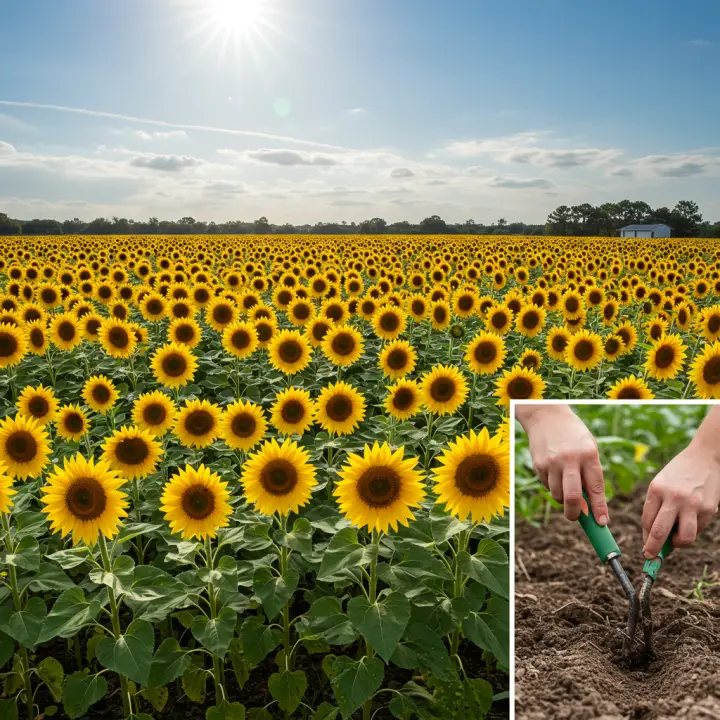Knowing the best time to plant sunflowers in Florida is crucial for successful growth and a vibrant bloom. This guide provides detailed information on planting times, ideal varieties, soil preparation, care tips, and answers to frequently asked questions, ensuring your Florida sunflower garden thrives.
Sunflowers, with their cheerful yellow faces, are a beloved addition to any garden. While typically associated with wide open fields bathed in summer sun, these vibrant blooms can thrive in Florida’s unique climate with proper planning and care. Understanding the nuances of Florida’s growing seasons, including its varying temperatures and rainfall patterns, is key to a successful sunflower harvest. This guide will delve into the intricacies of planting sunflowers in the Sunshine State, from selecting the right variety to harvesting your golden bounty.

When to Plant Sunflowers in Florida
Florida’s subtropical climate allows for a longer growing season than many other regions. This opens up opportunities to plant sunflowers multiple times throughout the year. However, careful consideration of temperature fluctuations and potential frost dates is crucial.
Planting Sunflowers in North Florida
North Florida experiences more distinct seasons, with cooler winters and hotter summers. The best time to plant sunflowers in this region is typically in early spring, after the last frost, which usually occurs around late February or early March. A second planting can be done in late summer, targeting a fall bloom. Aim for late August or early September to allow enough time for maturation before the first winter frost.
Planting Sunflowers in Central Florida
Central Florida enjoys a milder winter, which extends the planting window. Sunflowers can be planted from late winter through early spring (February to April) for a spring/early summer bloom. A fall planting in September or October can also be successful.
Planting Sunflowers in South Florida
South Florida’s warm, tropical climate allows for year-round sunflower planting. However, the hottest summer months (June-August) can be challenging. For optimal results, consider planting during the cooler, drier months from October to May. Successive plantings every few weeks can ensure a continuous display of sunflowers.
Choosing the Right Sunflower Variety for Florida
Selecting the right sunflower variety is just as important as timing your planting. Consider these factors:
Height: Sunflowers range from dwarf varieties, perfect for containers, to towering giants. Choose a size appropriate for your space. Popular choices for Florida include ‘Sunbeam’ (dwarf), ‘Mammoth Russian’ (giant), and ‘Autumn Beauty’ (multi-branched).
Bloom Time: Some varieties mature faster than others. Consider your desired bloom window when selecting.
Disease Resistance: Choose disease-resistant varieties to minimize potential issues in Florida’s humid environment.
Preparing Your Soil for Sunflowers
Sunflowers thrive in well-draining soil with a pH between 6.0 and 7.5. Amend your soil with compost or well-rotted manure to improve its fertility and drainage.
Soil Amendments
Compost: Improves soil structure and adds nutrients.
Manure: A rich source of organic matter, but ensure it’s well-rotted to avoid burning the plants.
Perlite: Enhances drainage, especially in clay soils.
Planting and Caring for Sunflowers
Follow these steps for planting and caring for your sunflowers:
1. Sowing Seeds: Plant seeds directly into the ground about 1 inch deep and 6-12 inches apart, depending on the mature size of the variety.
2. Watering: Water deeply and regularly, especially during dry periods. Avoid overwatering, which can lead to root rot. Mulching can help retain moisture.
3. Fertilizing: While not always necessary in fertile soil, a balanced fertilizer can boost growth. Apply a slow-release granular fertilizer at planting time or a liquid feed throughout the growing season.
4. Supporting Tall Varieties: Tall sunflowers may need staking to prevent them from bending or breaking in strong winds.
5. Pest Control: Be vigilant for common pests like aphids, snails, and birds. Use appropriate pest control methods, such as insecticidal soap for aphids or netting to protect from birds.
Harvesting Sunflowers
Harvest sunflowers when the back of the flower head turns brown and dry. Cut the stem about a foot below the flower head. Hang the heads upside down in a dry, well-ventilated area to allow the seeds to fully mature. Once dry, rub the seeds loose and store them in an airtight container.
FAQs: Growing Sunflowers in Florida
Q: Can I grow sunflowers in pots in Florida?
A: Yes, dwarf sunflower varieties thrive in containers. Choose a pot at least 12 inches in diameter and ensure good drainage.
Q: Do sunflowers need full sun in Florida?
A: Yes, sunflowers need at least 6-8 hours of direct sunlight per day to flourish.
Q: How often should I water sunflowers in Florida?
A: Water deeply and regularly, especially during dry spells. Allow the soil to dry slightly between waterings to prevent root rot.
Q: What are the common pests that affect sunflowers in Florida?
A: Aphids, snails, birds, and squirrels are common sunflower pests in Florida.
Q: Can I save sunflower seeds from my plants to grow next year?
A: Yes, you can save seeds from dried sunflower heads to plant the following year.
Conclusion
Growing sunflowers in Florida can be a rewarding experience, offering a vibrant splash of color and a bountiful harvest of seeds. By following these guidelines and understanding the specific needs of sunflowers in Florida’s climate, you can enjoy these cheerful giants year after year. Remember to choose the right variety for your region, prepare your soil properly, provide adequate sunlight and water, and protect your plants from pests. With a little care and attention, your Florida garden will be bursting with beautiful sunflower blooms.

